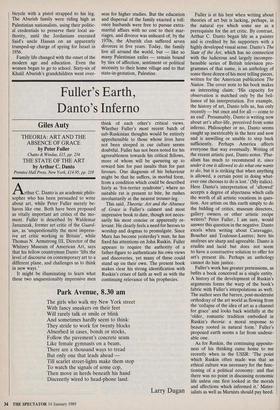Fuller's Earth, Danto's Inferno
Giles Auty
THEORIA: ART AND THE ABSENCE OF GRACE by Peter Fuller
Chatto & Windus, f15, pp. 234
THE STATE OF THE ART by Arthur C. Danto
Prentice Hall Press, New York, f14.95, pp. 218
Arthur C. Danto is an academic philo- sopher who has been persuaded to write about art, while Peter Fuller merely be- haves like one. Both have been proposed as vitally important art critics of the mo- ment. Fuller is described by Waldemar Januzszak, former art critic of the Guard- ian, as 'unquestionably the most impress- ive art critic working in Britain', while Thomas N. Armstrong III, Director of the Whitney Museum of American Art, says that his fellow countryman Danto 'lifts the level of discourse on contemporary art to a different plane, and challenges us to think in new ways.'
It might be illuminating to learn what these two unquestionably impressive men think of each other's' critical views. Whether Fuller's most recent batch of sub-Ruskinian thoughts would be entirely apprehensible to those whose lives have not been steeped in our culture seems doubtful. Fuller has not been noted for his agreeableness towards his critical fellows, more of whom will be queueing up to reward him for past insults than for past favours. One diagnosis of his behaviour might be that he suffers, in morbid form, from a condition which could be described fairly as 'fox-terrier syndrome'; where no suitable rat is present to bite, he rushes involuntarily at the nearest trouser-leg.
This said, Theoria: Art and the Absence of Grace is Fuller's calmest and most impressive book to date, though not neces- sarily his most concise or apparently re- levant. He clearly feels a need for heroes to worship and dogmas to promulgate. Since Marx has become yesterday's man, he has fixed his attentions on John Ruskin. Fuller appears to require the authority of a father-figure to authenticate his own views and discoveries, yet many of these could stand up on their own. The present book makes clear his strong identification with Ruskin's crises of faith as well as with the continuing relevance of his prophecies. Fuller is at his best when writing about theories of art but is lacking, perhaps, in the natural eye which some see as a prerequisite for the art critic. By contrast, Arthur C. Danto began life as a painter and is credited by his supporters with a highly developed visual sense. Danto's The State of the Art, which has no connection with the ludicrous and largely incompre- hensible series of British television pro- grammes of that name, is an anthology of some three dozen of his most telling pieces, written for the American publication The Nation. The cover note to his book makes an interesting claim: 'His capacity for observation is matched only by the bril- liance of his interpretation. For example, the history of art, Danto tells us, has only recently — but once and for all — come to an end'. Presumably, Danto is writing now about art's after-life, perceived from some inferno. Philosopher or no, Danto seems caught up inextricably in the here and now and is unwilling or unable to step back sufficiently. Perhaps America affects everyone that way eventually. Writing of the recent artistic past, Danto notes: 'Plur- alism has much to recommend it, since under it one is allowed to do what one wants to do, but it is striking that when anything is allowed, a certain point in doing what- ever one chooses to do is lost.' (My italics). Here Danto's interpretation of 'allowed' accepts a degree of abjectness which calls the worth of all artistic vocations in ques- tion. Are artists on this earth simply to do the bidding of critics, museum directors, gallery owners or other artistic recipe writers? Peter Fuller, I am sure, would answer this question in the negative. Danto excels when writing about Caravaggio, Boucher and Toulouse-Lautrec; here his analyses are sharp and agreeable. Danto is erudite and lucid but does not seem to have a constructive solution to offer for art's present ills. Perhaps an anthology cannot do him justice.
Fuller's work has greater pretensions, as befits a book conceived as a single entity. A history of the development of Ruskin's arguments forms the warp of the book's fabric with 'Fuller's interpolations as weft. The author sees the barren, post-modernist orthodoxy of the art world as flowing from the 'collapse of the idea of art as a channel for grace' and looks back wistfully at the 'older, romantic tradition embodied in Ruskin's theoria: a moral response to beauty rooted in natural form.' Fuller's proposed earth seems a far from undesir- able one.
As for Ruskin, the continuing apposite- ness of his thinking came home to me recently when. in the USSR: 'The point which Ruskin often made was that an ethical culture was necessary for the func- tioning of a political economy: and that there was no point in discussing economic life unless one first looked at the morals and affections which informed it.' Mater- ialists as well as Marxists should pay heed.


















































 Previous page
Previous page